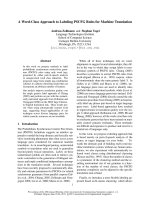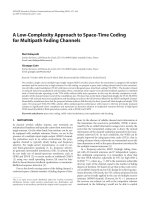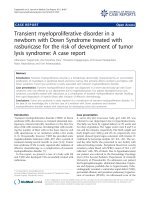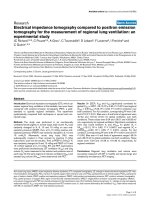A chemical genetics approach to identify targets essential for the viability of mycobacteria
Bạn đang xem bản rút gọn của tài liệu. Xem và tải ngay bản đầy đủ của tài liệu tại đây (1.75 MB, 109 trang )
I
A CHEMICAL GENETICS APPROACH
TO IDENTIFY TARGETS ESSENTIAL FOR
THE VIABILITY OF MYCOBACTERIA
STEPHEN HSUEH-JENG LU
NATIONAL UNIVERSITY OF SINGAPORE
AND
THE UNIVERSITY OF BASEL
2007
II
A CHEMICAL GENETICS APPROACH
TO IDENTIFY TARGETS ESSENTIAL FOR
THE VIABILITY OF MYCOBACTERIA
STEPHEN HSUEH-JENG LU
(B.Sc. (Hons.), University of Auckland)
A THESIS SUBMITTED FOR THE DEGREE OF MASTER OF SCIENCE
IN
INFECTION BIOLOGY AND EPIDEMIOLOGY:
INFECTIOUS DISEASES, VACCINOLOGY AND DRUG DISCOVERY
DEPARTMENT OF MICROBIOLOGY
NATIONAL UNIVERSITY OF SINGAPORE
AND
THE UNIVERSITY OF BASEL
2007
I
Acknowledgements
I want to take this opportunity to acknowledge the generous financial support of the
William Georgetti Scholarship from the New Zealand Vice-Chancellors Committee
(NZVCC, Wellington, New Zealand).
I would like to thank my supervisors, Dr. Vasan Sambandamurthy and Dr. Thomas Dick,
for the opportunity to work in the Tuberculosis Unit of the Novartis Institute for Tropical
Diseases (NITD). I would also like to thank them for their full support throughout the
duration of the course.
I thank all the members of the Tuberculosis Unit: particularly Srini, Mekonnen and in
alphabetical order, Amelia, Angelyn, Bee Huat, Boon Heng Cui Feng, Florence, Karen,
Kevin, Lay Har, Luis, Mahesh, Martin, Kai Leng, Kevin, Pamela, Penny, Sabai, Siew
Siew, Sindhu, Wei Fun (plus members that have left recently Sabine and Kakoli) for their
guidance, assistance, friendship and for being great lab members. In addition, I appreciate
the support/encouragement of Dr. Thomas Keller and for his friendliness.
I also appreciate the support and kindness of Mark, David, Viral, Xinyi, Sarah, Joanne,
Kim and Cindy of NITD. I also acknowledge the encouragement and assistance of the
lecturers/professors of Universtät Basel and the National University of Singapore,
particularly Dr. Markus Wenk and Professor Marcel Tanner.
I would like to thank my two flat-mates, Lukas and Tommy, for making this stay in
Singapore memorable. Importantly, I would also like to thank Yunshan, Cheryl, Adrian
II
and Pei-Ying for being great classmates and hanging together in Switzerland and
Singapore. I have many more people that I would like to thank but you know who you are
and I appreciate everything that you guys have done for and with me in the last 18 months.
Finally yet most importantly, I would greatly appreciate the love of my family and friends
(especially those that took the time to visit me from Germany, New Zealand, Hong Kong
and Malaysia) – i.e. Kenny, Matthias, Claudia, Shannon, Joanna, Janice, Tania, Jo-Ann and
Katie. My friends in Singapore, particularly Susie, Yunshan, Audrey, Joanne, Crystal,
Ingrid and several others – you guys have been great as well. Thanks Mum and Dad – you
guys are the best! And thanks Huimin for just being who you are.
III
Intellectual Property (IP) Statement
In compliance with the IP policies of Novartis, we are unable to display the chemical
structure of compounds as well as their compound names used in this study. Instead, we
have replaced the names of the two compounds used in this study as Compound X (the
compound isolated from the initial screen – CpdX) and Compound Y (the structure
derivative of CpdX taken from the Novartis compound library - CpdY).
IV
Table of Contents
Chapter 1: Introduction
1. Introduction 2
1.1. Tuberculosis 2
1.2. Epidemiology 2
1.3. Biology of tuberculosis 4
1.3.1. Immunology of tuberculosis 4
1.3.2. Clearing of primary infection by the immune system 4
1.3.3. Granuloma formation and caseous necrosis 5
1.3.4. Lung cavity 7
1.3.5. Extrapulmonary tuberculosis 7
1.3.6. Persistence, dormancy and latent tuberculosis 8
1.3.6.1. The nature of persistence (dormancy) of mycobacteria 8
1.3.6.2. Hypoxia-induced non-replicating persistence in M. tuberculosis – the
Wayne Model 9
1.3.6.3. Evidence of bacilli in the tissues of healthy PPD-positive individuals 10
1.3.6.4. Use of in vitro models of dormancy in drug discovery 11
1.4. Symptoms of pulmonary tuberculosis 11
1.5. Diagnosis of active and latent tuberculosis 12
1.6. Prevention, current treatment, DOTS and drug resistance 13
1.7. HIV Infection, AIDS and tuberculosis 15
1.8. Essential drug targets in M. tuberculosis 15
1.9. Chemical genetics as an approach for drug discovery 17
1.10. Technologies available for identification of drug targets 19
V
1.10.1. Confirmation of drug targets 19
1.10.2. Validation of drug targets 22
1.11. Goals of Tuberculosis Drug Research and Discovery 22
Chapter 2: Materials and Methods
2.1. Bacterial Strains, Growth Media, Compounds and Drugs 25
2.1.1. Bacterial Strains 25
2.1.2. Bacterial Culture Media 25
2.1.3. Glycerol stock of bacteria 26
2.1.4. Compounds 26
2.1.5. Drugs 26
2.2. Isolation and characterization of compound resistant mutants 27
2.2.1. MIC
50
and MBC
90
determination 27
2.2.2. Isolation of spontaneous compound-resistant mutants (mutation frequency
determination) 28
2.2.3. Selection of drugs to use in cross-resistance studies 29
2.3. Molecular Biology 29
2.3.1. Polymerase Chain Reaction (PCR) 29
2.3.2. TOPO cloning 31
2.3.3. Transformation of E. coli and mycobacteria 31
2.3.4. Restriction Enzyme Digestion 32
2.3.5. Agarose gel electrophoresis 32
2.3.6. Purification of digested plasmid DNA from agarose gels 33
2.3.7. Dephosphorylation of DNA 33
2.3.8. Ligation of DNA fragments 33
VI
2.3.9. Small scale preparation of plasmid DNA 34
2.3.10. Large scale preparation of plasmid DNA 34
2.3.11. Sequencing 34
2.4. Identification of drug target 35
2.4.1. Comparative Genome Sequencing 35
2.4.1.1. Genomic DNA preparation 35
2.4.1.2. Determination of DNA concentration and purity 36
2.4.2. 2D gel electrophoresis 36
2.4.2.1. Sample preparation 36
2.4.2.2. Electrophoresis 36
2.4.2.3. Silver staining 37
2.4.2.4. Spot identification 37
2.4.2.5. Database searching 38
2.4.2.6. Criteria for protein identification 38
2.4.3. Bioinformatics 39
Chapter 3: Results
3.1. Anti-mycobacterial activity of Compound X and Compound Y 41
3.2. Isolation of spontaneous resistant mutants to Compound X and Compound
Y in M. bovis BCG and M. smegmatis 42
3.3. Characterization of M. bovis BCG and M. smegmatis compound-resistant
mutants 43
3.4. Sequencing of M. bovis BCG and M. smegmatis mutant 46
3.5. Expression of corA in M. bovis BCG 49
3.6. Sequence alignment of the corA gene from various mycobacteria 52
VII
3.7. Proteomics of Compound X-resistant M. bovis BCG mutant and wild-type
M. bovis BCG with and without Compound X treatment 53
Chapter 4: Discussion
4.1. Physiological role of CorA 61
4.2. Is CorA the mode of entry or the target for CpdX and CpdY? 64
4.2.1. Target theory 64
4.2.2. Mode of entry theory 67
4.2.3. Other hypotheses – Only a Mechanism of Resistance? 68
4.3. Differences in the proteome derived from wild-type and mutant M. bovis
BCG 69
Chapter 5: Conclusion
5. Conclusion 73
Bibliography
Bibliography 76
Appendix
Appendix I: Comparative Genome Sequencing 93
VIII
Summary
The key goals for the development of new anti-mycobacterial drugs are to shorten the
treatment time and to have efficacy against latent as well as multi-drug resistant
tuberculosis. The best drug targets should be essential in both active and dormant phases
of the Mycobacterium tuberculosis infection, so that a single drug would eradicate both
populations. The only feasible way to elucidate such a novel target is to use a forward
chemical genetics approach. Forward chemical genetics involves screening a library of
compounds against the entire proteome for novel targets whose inhibition by one of the
compounds results in bacterial death or growth inhibition. The candidate drug/target pair
can be identified by microarray fingerprinting (Boshoff et al., 2004), proteomic profile
comparison as well as whole genome sequencing of spontaneous resistant mutants (Andries
et al., 2005).
We isolated M. bovis BCG mutants resistant to two structurally-related compounds, named
compound X and compound Y. The magnesium and cobalt transport transmembrane
protein, CorA, was identified as a putative target of these two compounds. This was based
on the mapping of genetic mutations to the corA gene from the compound-resistant mutant
strains. Moreover, the exogenous expression of the mutant copy of corA gene in wild-type
mycobacteria conferred high levels of resistance to these two compounds. However, due to
the non-essentiality of the corA gene and the bactericidal effect of the compounds, we
suggest that CorA is not the actual target and that it mediates an indirect mechanism of
resistance. More experiments are needed to identify and validate the biological target of
compound X and compound Y.
IX
List of Tables
Table 1.1: Current anti-tuberculosis drug targets with specific examples 17
Table 1.2: Technologies that can be used to identify the biological target of
compounds 21
Table 2.1: List of primers used for sequencing, expression and gene deletion
constructs 30
Table 3.1: Anti-mycobacterial properties of CpdX and CpdY against wild-type
M. bovis BCG and M. smegmatis 41
Table 3.2: Mutation frequency experiment for CpdX and CpdY in wild-type
M. bovis BCG and M. smegmatis 42
Table 3.3: The MIC
50
values for 23 standard drugs against wild-type M. bovis
BCG and M. smegmatis 44
Table 3.4: Cross-resistance study of CpdX and CpdY-resistant M. bovis BCG and
M. smegmatis mutants 45
Table 3.5: CorA mutations found in all the sequenced CpdX and CpdY-resistant
M. bovis BCG and M. smegmatis mutants 49
Table 3.6: Summary of 2D gel electrophoresis experiments 55
X
List of Figures
Figure 3.1: Results of Comparative Genome Sequencing 48
Figure 3.2: Expression of corA gene in wild-type M. bovis BCG 51
Figure 3.3: Comparison of the corA sequences from various mycobacteria 52
Figure 3.4: Example of protein identification by LC-MS; with analysis using
MASCOT and X! Tandem 56
Figure 3.5: 2D gel electrophoresis (18cm pH 4-7 strips) 57
Figure 3.6: 2D gel electrophoresis (18cm pH 4-7 strips) – close up 1 58
Figure 3.7: 2D gel electrophoresis (18cm pH 4-7 strips) – close up 2 59
Figure 4.1: Target theory versus mode of entry theory 64
Figure 4.2: Target versus Transporter theory when M. bovis BCG is complemented
with mutant corA gene or the wild-type corA gene 66
XI
List of Abbreviations
2D Two-dimensional
AIDS Acquired Immunodeficiency Syndrome
BCG bacille Calmette-Guérin
CDC Centers for Disease Control and Prevention
CFUs Colony Forming Units
CpdX Compound X
CpdY Compound Y
DOTS Directly Observed Treatment Short Course
HIV Human Immunodeficiency Virus
HTS High-Throughput Screening
LC-MS Liquid Chromatography-Mass Spectrometry
MBC Minimum Bactericidal Concentration
MDR-TB Multi-Drug Resistant Tuberculosis
[Mg
2+
]
Concentration of Magnesium
MIC Minimum Inhibitory Concentration
OD
600
Optical Density at a wavelength of 600nm
PCR Polymerase Chain Reaction
PPD Purified Protein Derivative
SNPs Single Nucleotide Polymorphisms
WHO World Health Organization
XDR-TB eXtensively-Drug Resistant Tuberculosis
1
Chapter One: Introduction
2
1. Introduction
The first part (Section 1.1 to Section 1.7) of this chapter will cover the clinical,
epidemiological and scientific information about the disease tuberculosis and its
causative agent. In the later parts, the use of chemical genetics to identify a compound
that targets a novel biological target and the tools available for identifying such a target
is presented (Section 1.8 to Section 1.11).
1.1. Tuberculosis
Tuberculosis is a contagious disease caused mainly by Mycobacterium tuberculosis
and sometimes M. bovis. M. tuberculosis is a relatively large, non-motile, rod-shaped,
acid-fast bacillus belonging to the family of actinomycetes (Parish and Stroker, 1998).
M. tuberculosis is an obligate intracellular parasite. In the laboratory, M. tuberculosis
can be grown on the agar-based Middlebrook medium or the egg-based Lowenstein-
Jensen medium (Parish and Stroker, 1998). Since it has a slow generation time of
around 18-20 hours, it takes 3-6 weeks for the bacteria to form visible colonies on
these solid media (Parish and Stroker, 1998).
1.2. Epidemiology
In the 19
th
century in Europe, tuberculosis, then known as the White Plague, was
responsible for 30% of total mortality (Merck, 2003). The World Health Organization
(WHO) estimates that globally two billion people are latently infected with
tuberculosis and that nine million people develop active disease annually, of which
two million die each year (Dye et al., 2006; Dye et al., 1999). M. tuberculosis
infections have reemerged as a major public health problem around the globe because
3
of poverty, neglect of the disease in the developed world, poor health services during a
crisis, migration of people from endemic countries, multi-drug resistant tuberculosis
(MDR-TB), and, lastly, due to HIV co-infection (Dye et al., 2006; Grange and Zumla,
1999; Manganelli et al., 2004; Espinal et al., 2001; Raviglione et al., 1997).
The WHO estimates that 90% of the tuberculosis cases occur in the developing world
(50% of those in the sub-Saharan desert region (Zumla et al., 2000; WHO, 2004))
where the disease predominantly affects the 15-54 years age group. This has a severe
economic impact on the patient’s family and his/her community. Tuberculosis disease
results in the loss of, on average, 20-30% of annual income or 15 years of income if
the disease results in death (WHO, 2004; Ahlburg, 2000). In contrast, in the developed
world the disease often occurs in the elderly or immunodeficient individuals.
Tuberculosis is classified as MDR-TB when the bacilli are resistant to at least the two
front-line drugs rifampicin and isoniazid. MDR-TB is on the rise in many parts of the
world, especially in the former Soviet Union (Espinal et al., 2001). In 2006, the
outbreak of a virulent XDR-tuberculosis (eXtensively Drug-Resistant; i.e. MDR-TB
that is additionally resistant to three or more second-line drugs) strain in South Africa
where 52 out of 53 patients died within one month of diagnosis further highlights the
importance of this disease (Associated Press, 2006; Centers for Disease Control and
Prevention, 2006).
4
1.3. Biology of tuberculosis
1.3.1. Immunology of tuberculosis
Infection of humans via the aerosol route with M. tuberculosis will result in latent or,
sometimes, active tuberculosis. Clinically, the primary infection could be controlled
entirely by the innate immune system and the infected individuals remain
asymptomatic (Grosset, 2003). However, the infection can also progress to a latent
state with a 10% lifetime chance of reactivation to active disease (Gedde-Dahl, 1952;
Grosset, 2003) (see Section 1.3.5. Persistence and Latent Tuberculosis).
1.3.2. Clearing of primary infection by the immune system
Most commonly, M. tuberculosis spreads when an infected patient expels small
droplets that contain the bacilli during sneezing, coughing or talking (Merck, 2005).
The most infective droplet is around 1-3µm in diameter (large droplets do not remain
airborne for long and do not reach the alveoli to establish an infection) and contains up
to three bacilli (Riley, 1974; Riley et al., 1962; Grosset, 2003). One to three weeks
following infection, the bacilli multiply exponentially in the macrophages, which at
this stage are not activated hence cannot effectively kill the mycobacteria (McDonough
et al., 1993; it should be noted that dendritic cells can also phagocytose mycobacteria
(Bodnar et al., 2001)). Subsequently, cellular immunity becomes activated when
infiltrating CD4
+
T-lymphocytes recognize the M. tuberculosis antigens presented on
MHC (Major Histocompatibility Complex) molecules of antigen presenting cells and
release cytokines (such as γ-interferon) that activate the macrophages (Grosset, 2003).
In addition, CD8
+
T-lymphocytes can also eliminate the infected macrophages
(Houben et al., 2006). Humoral immunity is ineffective against mycobacteria because
5
the bacilli are intracellular and, even when the bacilli are in extracellular spaces, the
thick cell wall prevents complement-mediated antibody killing.
At this stage, granulomas start to form at the foci of infection (see Section 1.3.2.
Granuloma Formation and Caseous Necrosis; Grosset, 2003). Some bacilli may
survive in this region of caseous necrosis for years (see Section 1.3.5. Persistence and
Latent Tuberculosis). Occasionally, the bacilli may spread to other parts of the lung or
to any part of the body via the bloodstream (see Section 1.3.5. Extrapulmonary
Tuberculosis; Merck, 2005).
It should be noted that in an immunocompetent host, the infection does not always
result in active disease (only 10% develop tuberculosis) (Enarson and Rouillon, 1994).
The lesions heal to form either the fibrous, calcified Ghon complex (in the primary
foci), nodular Simon foci (in other smaller foci) or calcified lymph nodes (Merck,
2005).
1.3.3. Granuloma formation and caseous necrosis
Tuberculous granulomas are a special type of lesion associated with tuberculosis
disease. It consists of caseous necrosis in the center of the lesion surrounded by giant
multinucleated Langhan’s cells, epitheloid cells (activated macrophages), lymphocytes
and fibroblasts (Canetti, 1955; Opie and Aronson, 1927; Adams, 1976; Bouley et al.,
2001; Grosset, 2003; Cosma et al., 2003). Caseation (derived from the word caseum
which means cheese) is a typical type of amorphous necrotic lesion that is associated
with tuberculosis (Canetti, 1955; Opie and Aronson, 1927; Grosset, 2003). As these
lesions develop, there is a huge reduction in the bacillary load within these lesions. In
6
the old caseous foci, there are very little, if any viable bacilli (Canetti, 1955; Opie and
Aronson, 1927; Grosset, 2003).
Caseous necrosis results from the infiltration of activated cytotoxic T-lymphocytes that
kill macrophages (or its derivatives the Langhan’s giant cells and epitheloid cells)
infected with M. tuberculosis as part of a necessary process to control the unimpeded
bacillary replication (Grosset, 2003). This immunological activity damages the host
tissue, but at the same time destroys a majority of bacteria. However, the bacilli do
survive extracellularly but cannot replicate because of low oxygen tension, acidic
environment within the caseous foci (Grosset, 2003). These physiological conditions
may prompt the tubercle bacilli to enter a state of non-replicating persistence (or
dormancy). This population of non-replicators is believed to be responsible for the
long treatment period of over six months (see Section 1.6. Prevention, current
treatment, DOTS and drug resistance).
In up to 90% of infected individuals, the T-cell activated macrophages will form the
granulomas and eventually eliminate most of the bacteria. Sometimes, the caseation
softens, spreads into the bronchial tree, and forms a lung cavity (see Section 1.3.4.
Lung cavity) where the bacilli multiply exponentially following exposure to high
oxygen levels (Canetti, 1955; Enarson and Rouillon, 1994). The softening of the
caseum into the large airways of the lungs progresses asymptomatic M. tuberculosis
infection into active tuberculosis disease.
7
1.3.4. Lung cavity
Lung cavities are the result of the softening of the caseum that is released into the
bronchial tree, which in turn allows the bacilli to grow extracellularly due to the
oxygen-rich environment (Long, 1935). A patient becomes infectious at this stage of
the disease when thousands of bacilli in the lung cavity are released as small droplets
during coughing or sneezing. Before the advent of antibiotics, around a quarter of all
immunocompetent patients with lung cavities control the disease via cell-mediated
immunity (see Section 1.3.3. Granuloma formation and caseous necrosis; Enarson and
Rouillon, 1994). Half of the untreated patients that develop cavitary tuberculosis die
within the first two years because bacilli released from the lung cavity will form new
granulomas and in due course destroy the entire lung (Enarson and Rouillon, 1994).
The remaining 25% of patients that do not receive any treatment will develop a chronic
tuberculosis infection.
1.3.5. Extrapulmonary tuberculosis
Infection of tuberculosis outside the lung can also occur, due to the spread of bacilli
either by the bloodstream or uncontrolled infection in the lung that spreads to nearby
organs (Merck, 2005). Miliary tuberculosis is a severe form of tuberculosis where
there is a widespread dissemination of bacteria throughout the body, presumably when
the infection destroys the blood vessel walls thus releasing bacilli into the bloodstream
(Merck, 2005). This form of tuberculosis is often fatal if left untreated. Tubercle
bacilli can also infect the peritoneum, genitourinary system, pericardium, lymph nodes,
bones, joints, gastrointestinal system, liver and meninges with varying degrees of
severity and clinical outcomes (Merck, 2005). For example, tuberculous meningitis is
associated with high morbidity and mortality in young children (Merck, 2005).
8
1.3.6. Persistence, dormancy and latent tuberculosis
Latent tuberculosis is a clinical condition where an individual is not sick with active
tuberculosis but is purified protein derivative (PPD)-positive (see Section 1.5.
Diagnosis of active and latent tuberculosis). As early as 1952, Gedde-Dahl described
the latency phenomenon and this observation was confirmed by fact that a patient
developed tuberculosis after 33 years of latent infection (Lillebaek et al., 2002). The
World Health Organization currently estimates that two billion people are latently
infected with M. tuberculosis, with the vast majority showing no symptoms or disease
(Dye et al., 1999). Despite this, there is still an ongoing discussion as to the true
nature of latency and how low bacillary numbers are maintained for many years.
Specifically it is uncertain if the M. tuberculosis enters a dormant state, or that a fine
balance between replication of the bacilli and its elimination by the host immune
system is achieved (Parrish et al., 1998 Cosma et al., 2003).
1.3.6.1. The nature of persistence (dormancy) of mycobacteria
There is a theory among researchers that latent tuberculosis is the result of the bacteria
lowering their metabolism and entering into a non-replicative state (also known as
dormancy). This theory supported by several pieces of compelling evidence. One, no
bacteria could be cultured when infected tissues containing acid-fast bacilli were used
as the inoculum (Manabe and Bishai, 2000, McKinney, 2000, Parrish et al., 1998 and
Cosma et al., 2003). It should be noted that the tissues were isolated from tuberculosis
patients undergoing treatment and it is not unconceivable that drug-treated M.
tuberculosis do not grow well under in vitro conditions. Two, despite sufficient
penetration of antibiotics in the diseased tissue, it is well known that under in vitro
conditions the bacilli are killed quickly, yet in human beings, a long course of therapy
9
is required (McKinney, 2000; Mitchison, 1979; Cosma et al., 2003). Nevertheless, the
bacilli may have divide occasionally during the latent stage because isoniazid (a
known cell-wall synthesis inhibitor; see Table 1.1) can decrease the risk of tuberculosis
reactivation in PPD-positive patients (Comstock et al., 1979; Cosma et al., 2003).
1.3.6.2. Hypoxia-induced non-replicating persistence in M. tuberculosis – the
Wayne Model
Many in vitro models have been developed to induce non-replicating persistence in
M. tuberculosis. These include models based on altering the pH, nutrient starvation,
hypoxia and nitric oxide levels (Dickinson and Mitchison, 1981, Heifets and
Lindholm-Levy, 1992, Betts et al., 2002, Nathan and Shiloh, 2000; Wayne and
Sohaskey, 2001). In particular, the hypoxia-induced Wayne model has been studied
and established in great detail (Wayne and Sohaskey, 2001). Although oxygen levels
within granulomas have not been determined, there is ample evidence to suggest that
latent tuberculosis is the result of the survival of M. tuberculosis in an oxygen-
deficient environment. Infection and reactivation is most commonly associated with
the superior lobes of the lung where the oxygen tension is higher (Adler and Rose,
1996). Moreover, non-dividing bacilli can remain viable without oxygen in a
presumably dormant state for several years (Canetti, 1955; Corper and Cohn, 1933).
In the Wayne model, mycobacteria are grown in sealed glass tubes with magnetic
stirrers under a defined head space ratio of 0.5. The constant stirring ensures a uniform
distribution of cells throughout the Dubos medium in such a way that the oxygen in the
head space is slowly depleted to create a three-stage growth curve. The bacterial
growth can be monitored by measuring the absorbance of the cultures periodically.
10
The bacteria grow exponentially for the first 5 days due to the presence of dissolved
oxygen in the medium. The shift into the first stage of non-replicating persistence
phase 1 (NRP1) occurs as the dissolved oxygen levels reach around 1%. NRP1 is
characterized by a slight increase in turbidity without a concomitant increase in the
bacterial colony forming units (CFUs). At day 10, the methylene blue indicator starts
to fade and the decolorization is complete by day 12. This stage of non-replicating
persistence phase 2 (NRP2) occurs when the oxygen level reaches 0.06% of normal
saturation (anaerobic) and no further increase in optical density is seen (Wayne and
Hayes, 1996; Wayne and Sohaskey, 2001). The bacteria from NRP2 show phenotypic
isoniazid resistance.
1.3.6.3. Evidence of bacilli in the tissues of healthy PPD-positive individuals
These latent bacilli have been found in humans albeit in very low numbers. A few
CFUs were isolated from pathologically normal lungs of people who had died from
unrelated causes (Canetti, 1955; Feldman and Baggenstoss, 1938; Opie and Aronson,
1927; Grosset, 2003). Using in-situ PCR, M. tuberculosis DNA was found in the lung
samples of individuals from Ethiopia and Mexico; both countries have a high
prevalence of tuberculosis (Hernandez-Pando et al., 2000). Moreover, as noted earlier,
isoniazid significantly reduced the risk of disease in PPD-positive people suggesting
that there must be viable bacilli within the lung tissue (Comstock et al., 1979; IUAT,
1982). Moreover, hypoxic bacilli within tuberculosis lesions were imaged in vivo
using pimonidazole probing (Barry et al., Tanzania, 2005).
11
1.3.6.4. Use of in vitro models of dormancy in drug discovery
The current drugs affect processes essential during replication and active metabolism,
such as protein and cell wall synthesis, but show little or no activity against quiescent
bacilli (see Section 1.8. Essential drug targets in M. tuberculosis; Dick, 2001; Boshoff
and Barry, 2005). This resistance phenomenon observed with dormant bacteria is
known as phenotypic, as opposed to genetic, drug resistance. Hence, one of the central
goals of modern anti-mycobacterial drug discovery is the identification of compounds
that can target both actively replicating as well as the non-replicating mycobacteria.
By employing in vitro screens, it is possible to isolate potent compounds by
determining their inhibitory/bactericidal concentrations on mycobacteria growing
under aerobic and hypoxic conditions.
1.4. Symptoms of pulmonary tuberculosis
Symptoms of active pulmonary tuberculosis include constant coughing, tachycardia,
chest pain and swollen lymph nodes in the neck (Merck, 2006). It should be noted
that, contrary to common belief, bloody sputum is rarely seen in patients. Fatigue,
fever, loss of appetite, chills and night sweats can also occur in many patients (Merck,
2006). However, symptoms of pulmonary tuberculosis are mild and usually develop
gradually, thus may easily go unnoticed by patients. In extrapulmonary tuberculosis,
the symptoms are more variable and dependent on the type of infected tissue, for
example back pain and neurological defects could be symptoms of spinal tuberculosis
(Merck, 2006).
12
1.5. Diagnosis of active and latent tuberculosis
The current gold standard for diagnosis of active tuberculosis is to microscopically
determine the presence of acid-fact bacilli in patient’s sputum samples following
isolation of M. tuberculosis in culture (Merck, 2005; Nahid et al., 2006). Other useful
tuberculosis diagnostic tools include chest X-ray, tuberculin skin test and IFNγ-based
assays (Merck, 2005; Nahid et al., 2006).
Until recently, the tuberculin or Mantoux test, where purified protein derivative (PPD)
of M. tuberculosis is injected intradermally, was the only method available for
diagnosis of latent tuberculosis (Merck, 2005; Nahid et al., 2006). However, these
results can be confounded by prior BCG vaccination and exposure to non-tuberculous
environmental mycobacteria (Nahid et al., 2006; Pai, 2005). These problems led to the
development of γ-interferon based assays (e.g. QuantiFERON-TB Gold test (Cellestis
Ltd., Australia)) using two region of difference (RD-1) antigens, namely 6-kDa early
secreted antigenic target (ESAT-6) and 10-kDa culture filtrate protein (CFP-10)
(Nahid et al., 2006; Pai et al., 2004; Dheda et al., 2005; Pai, 2005; Lalvani, 2003).
Studies have shown that these tests are more specific, especially in patients who have
received BCG vaccination, and are proven to be more sensitive than the Mantoux test
(Nahid et al., 2006; Pai, 2005). Furthermore, the tuberculin skin test is subjective (i.e.
the reading is dependent on the attending physician). Polymerase chain reaction (PCR)
based diagnostics tests have also been developed, such as Amplicor MTB tests (Roche
Diagnostic Systems, United States) (Nahid et al., 2006).
Until recently, it is necessary to culture the M. tuberculosis strains isolated from
patients in order to determine the antibiotic susceptibility patterns to design an









